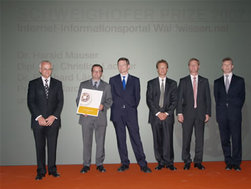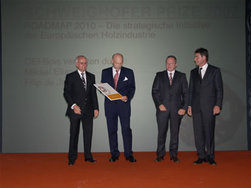Winners 2007
Main Prize
Prof. Matti Kairi
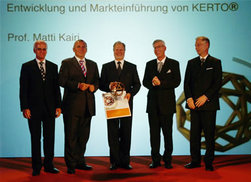
left to right:
Gerald Schweighofer, Austrian Federal Chancellor Dr. Alfred Gusenbauer, winner Prof. Matti Kairi, Prof. Alfred Teischinger (Head of jury), Ole Salvén
Prof. Matti Kairi dedicated the major part of his professional life to the interaction of R&D and busi-ness development in the wood products industry surrounding Kerto®-Laminated Veneer Lumber (LVL). After finishing his studies in Wood Technology, Prof. Matti Kairi started his career at the Metsäliitto Group, where he was responsible for all development work on Kerto®, starting from the product idea and proceeding through various phases until its breakthrough into international markets. He holds nine patents related to Kerto®. In 2002 Prof. Matti Kairi moved to the Helsinki University of Technology, where he is Professor and Head of the Laboratory of Wood Technology.
In Kerto®-LVL, 3 mm veneer sheets are glued together to form a continuous wide billet, where the fibre orientation in veneers is primarily lengthwise in relation to the processing direction. The billets can be cut to size as structural beams and studs to be used as such, or for further processing into building components. Wood defects can thus be distributed and therefore, in comparison with sawn timber, this results in a significantly more homogeneous product, with high-quality weather-proof characteristics. Kerto® is used in Scandinavia as beam or column. Its characteristic strength values are 43-67 % higher than those of German glued laminated timber (glulam) “Güteklasse I”, depending on loading category. Kerto® has grown from zero to a business of over 100 million € per year, and sales in over 15 European countries as well as USA, Australia and Japan. One of the most prominent buildings where Kerto® was used as a construction material is the Sibelius Hall in Lahti.
CATEGORY FORESTRY INNOVATION PRIZE
Transnational Internet Information Platform Waldwissen.net
The main goal for the platform, which is online since the beginning of 2005, is to offer stakeholders concise updated information about all topics concerning forestry. Usually a wide range of scientific and practical reports and articles can be found in a variety of different sources. Searching for a complete overview of one specific topic takes considerable effort and wastes time. Therefore many decisions in forestry practice are taken on a very poor knowledge base. The Waldwissen.net team is able to provide over 1,500 articles in five different languages: German, English, French, Italian, and Slovenian. The next steps are editing and translating of further contributions heading towards 2,500 in the year 2008. Additionally, an interactive expert system will be installed enabling users to get into contact with experts for solving specific problems. A training platform is already established.
In order to enlarge the expertise with reference to wood technology, the platform is searching for at least one or two additional partner institutions.
CATEGORY WOOD TECHNOLOGY INNOVATION PRIZE
Industrial X-Ray Log Scanner with a feed speed of 3m/sec
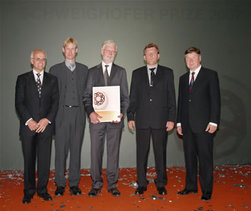
left to right:
Gerald Schweighofer, Dr. Johan Oja, Prof. Anders Grönlund, Dr. Stig Grundberg, Prof. Tero Paajanen (Jury)
After graduating as a Mechanical Engineer, Prof. Andres Grönlund worked for several research institutions and also in the woodworking industry. Since 1988 he is Professor for Wood Technology at Luleå University of Technology’s Skellefteå Campus. Dr. Stig Grundberg is also a Mechanical Engineer and has been working at Luleå University of Technology’s Skellefteå Campus, and at SP Trätek since 1985. Their specific expertise is in wood production technology with emphasis on improving exploitation of wooden raw material, wood machining and scanning technology. Dr. Johan Oja studied Engineering Physics and started his career also at Luleå University of Technology. In 2002 he was guest researcher and X-ray expert at Forintek in Vancouver, Canada. He also is working at SP Trätek. His main research interests are image processing and multivariate statistical modelling.
The ultimate goal is to obtain full knowledge about the properties of every sawlog in order to pro-duce quality optimized and customer oriented wooden products. The X-ray Log Scanner can measure many different features related to or explained by the variations of green density or the outer shape of the logs, such as wood species, type of log, diameter under bark, different knot parameters, annual ring width, commodity grades, density, heartwood content, strength, rotational position and spiral grain. The X-Ray Log Scanner is already used by several companies in the European woodworking industry.
CATEGORY WOOD PRODUCTS INNOVATION PRIZE N°1
Innovative wood product using polymer integration
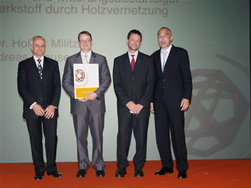
left to right:
Gerald Schweighofer, Dr. Andreas Krause, Prof. Holger Militz, Dr. Manfred Brandstätter (Jury)
Prof. Holger Militz graduated in Wood Technology in Hamburg. In the Netherlands he held several leading positions in research institutions (including TNO Delft, and SHR Wageningen which he founded) before he became Professor and Head of the Institute of Wood Biology and Wood Technology in Göttingen, Germany in 2000. Prof. Militz is a well-known expert in wood modification and wood preservation. Dr. Andreas Krause graduated in Forestry and is currently a scientist at the Institute of Wood Biology and Wood Technology in Göttingen, specialising in the field of wood-polymer integration.
The winning team aimed at finding an innovative solution for the increasing demand for wood that is suitable for external use or weathered conditions. As wood treated with preservatives, or tropical wood species, are not satisfactory alternatives; they were looking for technologies from other areas. The textile industry uses specific polymers for cotton treatment in order to improve specific material properties. As cotton is a cellulose material like wood, Militz and Krause took that example and started their research work on wood polymer integration using Dimethyloldihydroxyethyleneurea (DMDHEU).
Tests with different wood species (beech, pine, birch, poplar) were very promising in relation to dimensional stability, water resistance, weathering, durability and surface quality.
Industrial partners are continuing the product development work on an industrial scale, a brand name is registered and the production of a variety of, for example, garden furniture has started in 2006. At the moment, research work is continuing on the development of particle boards using integrated chips.
CATEGORY WOOD PRODUCTS INNOVATION PRIZE N°2
HIPERWOOD® - The Extruded Wood-Duroplastic– Composite based on Melamine
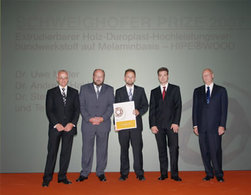
left to right:
Gerald Schweighofer, Dr. Uwe Müller, Dr. Andreas Haider, Dr. Steffen Pfeiffer, Bo Borgström (Jury)
The production of wood plastic composites (WPC) was so far based on a thermoplastic matrix such as polypropylene or PVC, as thermo-plasticity was one of the main requirements for the extrusion process. Indeed, WPC reacts to increasing temperatures with a decisive loss of strength and stability, which is quite disadvantageous, for instance in construction applications. In order to improve the overall stability and strength of WPC, the team developed a new wood plastic composite using melamine as a duroplastic matrix that is unique worldwide. Many development steps had to be taken before Hiperwood® could be produced. The modification of the melamine resin, the extrusion process, the extrusion tools and the integration process had to be defined in different ways. The range of applications is wide, and especially in Europe there is potential to use it for instance in prefabricated houses or windows. Hiperwood® is planned to be launched at the market in 2008.
INNOVATION PRIZE COOPERATION AND EDUCATION
ROADMAP 2010 – First ever strategic cooperation project of the European Woodworking Industries
CEI-Bois, the European Confederation of woodworking industries, was founded in 1952 by regrouping the European woodworking and furniture industries, which includes more than 186,000 companies employing around 3 million workers in the EU-25. CEI-Bois is an umbrella organization with 35 members, of which 27 are national associations and eight are branch organizations. The primary goal of CEI-Bois is to further the interests of the European wood sector. CEI-Bois is currently represented by the Chairman Mikael Eliasson (Setra Group) and the Secretary General Filip de Jaeger.
By 2004 it had become clear that wood products were losing market share for various reasons such as EU-policy, limited industrial cooperation, competing materials and European standards. CEI-Bois then started the Roadmap 2010 process with the vision that wood and wood-based materials should become the leading material by 2010. Roadmap 2010 comprises four main processes: Building with wood, Living with Wood, Wood in Packaging and Transport and Wood in Sustainable Development. Each of these processes is industry driven, with steering groups composed of industrialists. The actual work is performed within expert and/or working groups, based on action plans that correspond to the needs identified for each field of activity.


